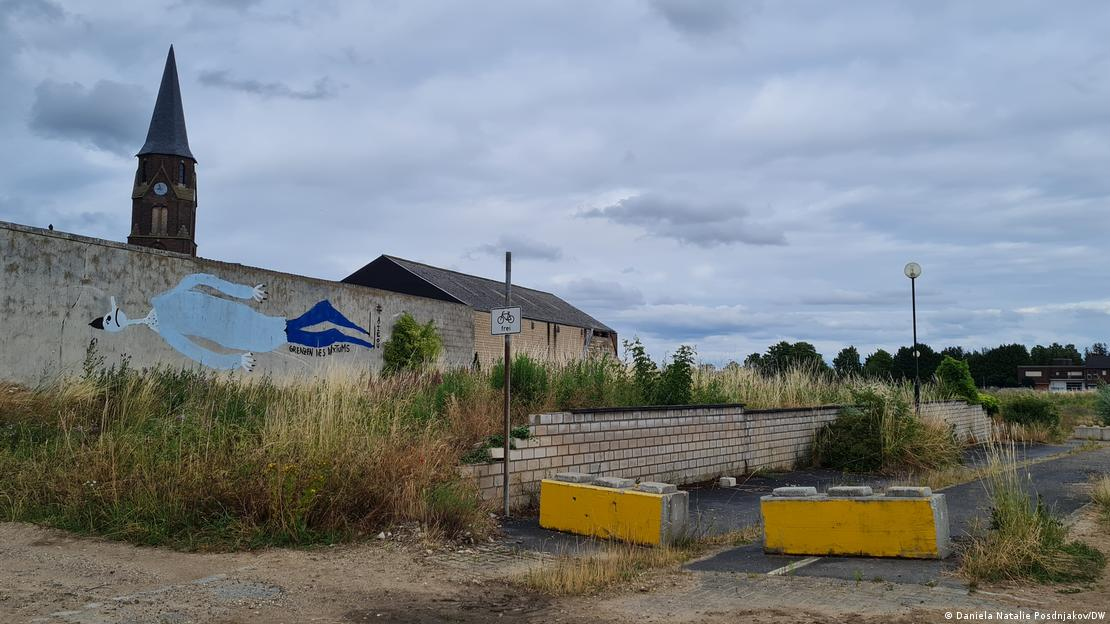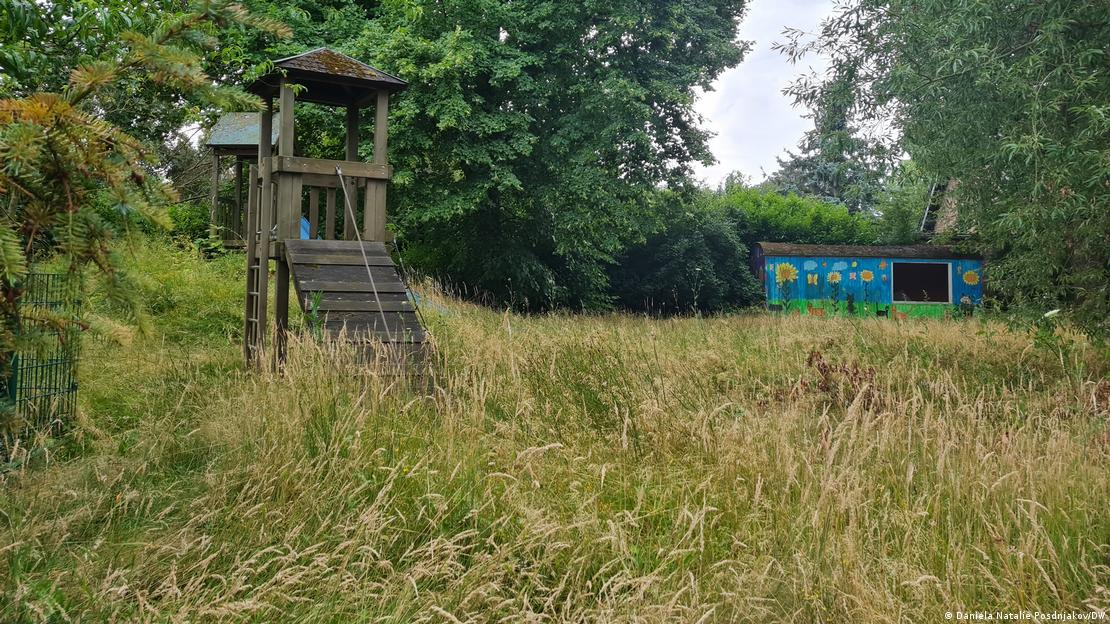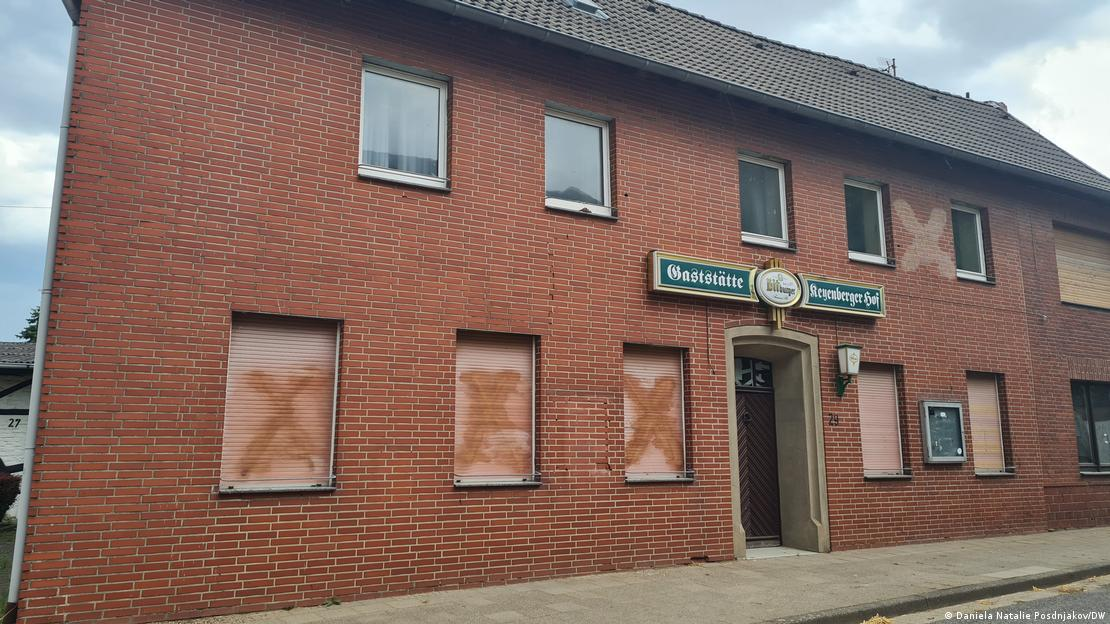If you open Google Maps to look at the western German state of North Rhine-Westphalia, you'll notice three large pale patches. They represent three colossal open-pit mines — Inden, Hambach and Garzweiler — where the energy company RWE is extracting brown coal (lignite) from the earth.
Right next door are towns and villages that have stood abandoned for months or, in some cases, years. These "ghost towns" were originally set to be demolished to make way for more mining, but with the German government's decision to phase out coal, their future is now unclear.
Near the Hambach surface mine, which opened in 1978 and is set to close by 2030, are the two "ghost villages" of Morschenich and Manheim, supposedly fated for demolition to make way for mining.

Arriving in Manheim, you see rows of houses with their shutters rolled down and their windows boarded up. The asphalt road is torn up and the street lights are broken. In the center of the village stands a Catholic church, which also has its windows nailed up. Some of the houses still in good condition are surrounded by barbed wire. A sign declares who their owner is: RWE.
'We're not complaining whatsoever'
You don't meet many people here. Technically, there be shouldn't any at all, as is also the case in neighboring Morschenich. Here too, rows and rows of houses stand empty, their windows sealed off and the grass out front growing tall. At first glance, you might mistake it for another "ghost village."
But if you look closely, you'll see that some of the houses in Morschenich have white paper labels tacked onto their doors. On one is a Ukrainian name, another an Arabic one. In one of these lives a Ukrainian couple, Denis and Julia, whose names have been changed to protect their identity.
They have been in Morschenich since December 2022, they told DW. The once single-occupancy house is now home to several people — a Ukrainian family from Donbas and refugees from Syria, a sort of a small refugee shelter.
"We're not complaining whatsoever. We have electricity, water, heating, even Wi-Fi and mobile internet," Denis says. "We can call home to Ukraine. People working for local authorities come every week and help us with paperwork. We get social welfare benefits regularly. The only thing we haven't had yet is language courses."
The fact that the town lacks shops and has no drugstore or doctor doesn't bother them. Julia drives to the neighboring village to get groceries, she explains. Next to the house is a car with Ukrainian license plates.

"When we first got here, nothing was clear to us. Later, someone explained to us what kind of place it is. But back home in Ukraine, we had been under fire for three months, and here it is peaceful," they say.
They point out to the woods beginning just on the other side of a field. "Climate activists live there," Denis says. "They've built houses in the trees. Sometimes we see them, but they don't bother us." The police come regularly to check that everything is okay, he adds.
There are several Ukrainian families living in Morschenich these days. Denis and Julia see them when local authorities come by or when they go out for a walk. "It looks boring here at first glance, but we go berry picking," Julia says.
"Sometimes we go into town, but it's so loud there that we are happy when we get back to the country," Denis adds.
The couple say they don't know how long they will stay in this place. "Apparently they won't demolish this village. The municipality sent us here, but first we were in a refugee camp in [nearby city] Bochum, so we will stay here until they resettle us," Julia says.
Morschenich is indeed to be spared destruction, according to the latest plans. Germany has pledged to phase out coal-fired power stations altogether by 2038 as part of its bid to curb carbon emissions.

RWE confirmed the plan to DW. "The places mentioned are no longer set to be razed," the spokesperson said. "We made the houses and flats in question, which we had previously bought from families being resettled, available to people in urgent need of a roof over their heads at the request of local authorities."
Once a school, now a refugee shelter
Not far away, located near another surface mine called Garzweiler II, are the villages of Kuckum and Keyenberg. Residents here were also bought out of their homes and relocated. Soon, the two towns are set to disappear.
Next door is Lützerath, a village that became famous earlier this year due to a wave of climate protests that saw Swedish youth activist Greta Thunberg pay a visit. It too is set to be razed this year, and all the roads leading there are closed.
But Keyenberg can still be reached by car. At first glance, it looks just like the other abandoned villages: The same narrow streets with rows of well-built but empty houses surrounding a Catholic church.
A few meters further down the road is the school building, from which several people suddenly emerge. They carry chairs out with them and put them in the schoolyard. It's a hot day.
"We live here. We come from Syria," one man says before quickly disappearing. Whether they really reside there is unclear. Nobody is willing to talk, everybody retreats back into the building.

Next to the school there is a bus stop with a timetable. Keyenberg is still served by public transport. On the door of a bakery opposite the church, the opening hours are displayed — just a few hours on some days of the week. There are no longer any real stores or pharmacies here and almost all the shops are empty. But the presence of several parked cars suggests that some houses are inhabited.
"There are still residents in Keyenberg, but about 80% have moved away after receiving compensation. About 15-20% are still there," Irina Becker, a local councilor in the nearby city of Bochum of the center-right Christian Democratic Union (CDU), told DW.
"Refugees are also currently living here," added Becker, who sits on Bochum council's integration committee. "The old school has been set up for them. Several houses also serve as accommodation. Some are used individually, others in the form of shared accommodation.
"There is electricity, water and heating. Language and integration courses have been organized for the refugees living here and the children go to preschool," she says.
Who is sending refugees to abandoned villages?
There is also a Ukrainian family with a child in Keyenberg. They decline to give their names, but explain that they were "in Poland for a long time." On social media, they learned that you could go to Bochum and be assigned to a major city like Düsseldorf or Cologne. But in the end, they say state authorities sent them first to the smaller town of Erkelenz, and then to Keyenberg.
Refugees are automatically distributed among Germany's 16 states and thousands of municipalities according to certain quotas, and homes are assigned according to need.

The state government of North Rhine-Westphalia had not yet responded to DW's questions about placing refugees in empty villages by the time this piece was published, and local authorities in the municipalities of Erkelenz and Merzenich were not reachable for comment.
The Ukrainian refugee family in Keyenberg say they like the village. For the moment, they are alone in the house, but another family from Ukraine is expected to join them soon. They admit that they were initially alarmed. "But it's better here than lying on a cot in a gymnasium somewhere," they say, thinking of their acquaintances who still live like that.
As long as there is war in Ukraine, they do not want to return. They might stay in Germany even after the war ends. "Let's see, at the moment everything is fine," the Ukrainians say. "The village will not be demolished. Maybe we will stay here if we are allowed."